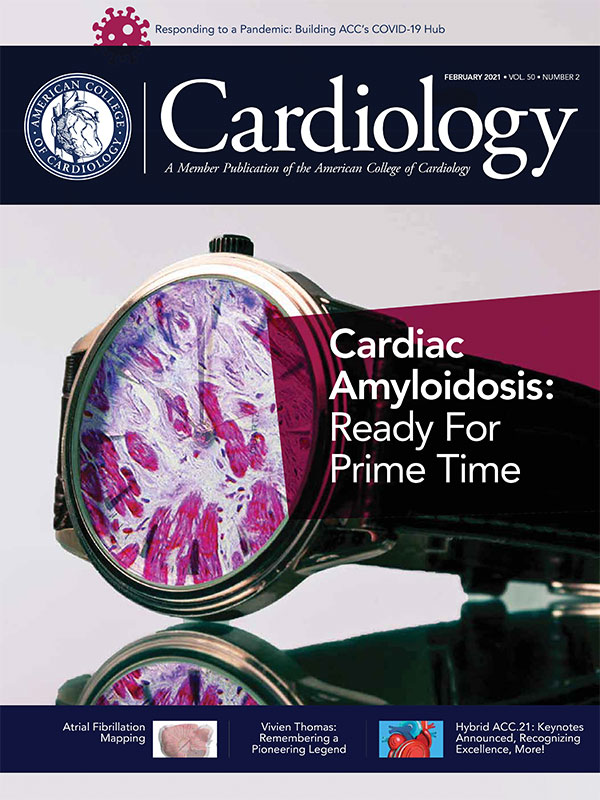Journal Wrap

The hottest research from various peer-reviewed journals – handpicked weekly by the ACC.org Editorial Board led by Kim A. Eagle, MD, MACC.
Paper Addresses Key Areas of Uncertainty in COVID-19 and the Athletic Heart
As critical data to advance the understanding of COVID-19 outcomes in athletes is currently being collected, thoroughly rehearsed emergency action planning represents the best strategy to save lives, according to a paper published in JAMA Cardiology.
Jonathan H. Kim, MD, MSc, FACC, a member of ACC's Sports and Exercise Cardiology Section Leadership Council, et al., address the most common questions regarding COVID-19 and cardiac pathology in athletes in competitive sports, including the extension of return-to-play considerations to discrete populations of athletes not addressed in prior recommendations. In the absence of definitive data, the authors explain there is ongoing uncertainty about the optimal approach to cardiovascular risk stratification of athletes in competitive sports following COVID-19 infection.
Kim JH, Levine BD, Phelan D, et al. JAMA Cardiol 2020;Oct 26:[Epub ahead of print].
NCDR Study: Better Outcomes With CRT-D vs. Dual-Chamber ICD in Patients Requiring Ventricular Pacing
CRT use may be associated with better outcomes among older patients undergoing ICD implantation with a bradycardia pacing indication but without a class I indication for CRT, according to a study published in JAMA Network Open.
Using data from ACC's ICD Registry, Ryan T. Borne, MD, FACC, et al., examined trends, variability and outcomes in the use of CRT-D and dual-chamber ICD devices between 2010 and 2016 in 3,100 Medicare beneficiaries with a class I or II guideline ventricular bradycardia pacing indication who did not have a CRT class I indication based on left ventricular ejection fraction (LVEF). The researchers looked at all-cause mortality, heart failure (HF) hospitalization and device-related complications.
According to the results, the mean age of patients was 76.3 years, and 80.6% were men. At baseline, 69.9% (2,167) patients had ischemic heart disease, 40.6% (1,260) had third-degree atrioventricular block and 31.1% (965) had second-degree atrioventricular block. The average LVEF was 31.2%.
Overall, 1,698 patients (54.8%) underwent CRT-D and 45.2% (1,402) underwent dual-chamber ICD. Patients receiving dual-chamber ICD were more likely to be women, have higher average LVEF, have a history of ventricular tachycardia and have shorter QRS duration, while those undergoing CRT-D were more likely to have third-degree atrioventricular block, nonischemic cardiomyopathy, a primary prevention indication, prior HF hospitalization, more advanced NYHA class, and a right bundle branch block or a left bundle branch block.
After adjustment, CRT-D implantation was associated with lower one-year mortality (hazard ratio [HR], 0.70; 95% confidence interval [CI], 0.57-0.87; p=.001) and HF hospitalization (subdistribution HR, 0.77; 95% CI, 0.61-0.97; p=0.02). There was no difference in complications among patients undergoing CRT-D implantation vs. dual-chamber ICD implantation. The use of CRT-D increased throughout the study period, accounting for 48.4% of implantations in 2010 and 60.9% in 2016.
The researchers conclude that CRT use was associated with better outcomes, including lower mortality and HF hospitalization, among patients undergoing ICD implantation with bradycardia pacing indication but without a class I CRT indication. Going forward, randomized and real-world investigations are needed to confirm the findings and potentially expand CRT use among patients with normal LVEF who require frequent right ventricular pacing.
Clinical Topics: Arrhythmias and Clinical EP, COVID-19 Hub, Heart Failure and Cardiomyopathies, Prevention, Sports and Exercise Cardiology, Implantable Devices, EP Basic Science, SCD/Ventricular Arrhythmias, Atrial Fibrillation/Supraventricular Arrhythmias, Acute Heart Failure
Keywords: ACC Publications, Cardiology Magazine, Bundle-Branch Block, Stroke Volume, Atrioventricular Block, Bradycardia, Uncertainty, Uncertainty, Confidence Intervals, Leadership, Leadership, COVID-19, Cardiovascular Diseases, Cardiovascular Diseases, Ventricular Function, Left, Medicare, Risk Factors, Arrhythmias, Cardiac, Heart Failure, Tachycardia, Ventricular, Tachycardia, Ventricular, Cardiomyopathies, Hospitalization, Myocardial Ischemia, Registries, Athletes, Primary Prevention
< Back to Listings

